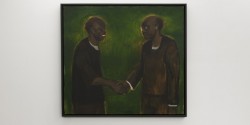Tuesday through Sunday from 12:00 until 21:00
Closed Monday
Admission is Free


The glossy, blue-chip contemporary art owned by the Ukrainian collector vies with the cerebral, sometimes obscure work produced by the young artists up for the prize that Pinchuk has funded
Two opposing visions of contemporary art collide at the Pinchuk Art Centre in Kiev (PAC), a private space funded by steel magnate Victor Pinchuk. The glossy, high-impact, market-friendly work of Jeff Koons, Damien Hirst, Takashi Murakami and Andreas Gursky drawn from the Ukrainian collector’s own holdings are shown in a succession of rooms on the fourth floor, while Hirst’s latest cycle of still-life paintings, shown at White Cube gallery in London earlier this year, get their own exhibition on the second floor.
Meanwhile, the bulk of PAC’s space is currently given over to videos, performances, sculptures and installations by 21 young international artists shortlisted for the Future Generation Art Prize (until 6 January 2013), a $100,000 biennial award, set up and financed by Pinchuk, which is open to any artist under the age of 36 anywhere in the world.
The artists in this show produce cerebral, highly conceptual, sometimes obscure work of the sort that is currently very much in favour in European curatorial circles.
The Future Generation jury comprises Carolyn Christov-Bakargiev, fresh from her stint at the helm of Documenta in Kassel; Nancy Spector, the deputy director and chief curator of the Guggenheim Museum, New York; Massimiliano Gioni, the associate director of the New Museum, New York and the curator of the next Venice Biennale; Hans Ulrich Obrist, the co-director of the Serpentine Gallery, London; the curators Carol Yinghua Lu and Agnaldo Farias from China and Brazil respectively; as well as the Pinchuk Art Centre’s general director Etckhard Schneider, formerly the director of the Kunsthaus Bregenz.
That such an illustrious panel has agreed to judge a prize funded by a private collector is testament to the reputation of Schneider; to Pinchuk’s determination to put his museum on the international art world map; and to the enormous influence that comes with enormous spending power (Pinchuk is worth $4.2bn according to Forbes magazine and Alfred Pacquement, Glenn Lowry, Richard Armstrong and Nicholas Serota, respectively heads of the Centre Pompidou, MoMA, the Guggenheim and Tate, all serve on the board of the Future Generation prize.)
Pinchuk has no involvement in the award or the choice of artists beyond financing it. Indeed, he told The Art Newspaper after the award ceremony on Friday 7 December, that he finds some of the work selected this year mystifying: “It’s very smart” but “very ugly”, he said. He has a point.
Standing in front of a grainy video of a barren landscape by the Italian artist Micol Assaël which is accompanied by a soundtrack of buzzing bees, a work which won the artist one of the five smaller special awards of the evening, one wonders if curators sometimes organise shows for the benefit of their professional colleagues rather than the public. According to the information on the wall text, the viewer is meant to complete the work by “perceiving the invisible”. It’s a handy disclaimer: if you don’t get it, you’re not trying hard enough.
There’s not much more information elsewhere to guide viewers. The winning artist, the British painter Lynette Yiadom-Boakye is represented in Kiev by a selection of painted portraits of anonymous black men. But at the prize ceremony, Christov-Bakargiev insisted Yiadom-Boakye won the $100,000 award not for her canvases but for her “complex practice, which extends far beyond painting”. If the message people take from this prize is that “painting is back” it would be a “disaster” said Christov-Bakargiev. Yet paintings by Yiadom-Boakye are all we, the public, have to judge her work by in the exhibition.
Some of the best art in the display lies somewhere between the easily consumable works favoured by Pinchuk and the frankly perplexing work of artists such as Assaël. One of the highlights is the evocative landscape of 4,000 wood block toys cast in concrete by the Lebanese artist Rayyane Tabet. Another is an installation of split-screen videos by the Japanese artist Meiro Koizumi, which is technically accomplished and visually appealing but complex enough to reward sustained viewing.
Koizumi, who will have a show at MoMA opening 9 January as part of the institution’s Projects series, explores notions of Japanese guilt and commitment to country. In Portrait of a Young Samurai, 2009, a young actor recites a final message to his parents before embarking on a suicide mission, while off-screen the artist directs him to inject more emotion into his words until the performance reaches its heartbreaking finale. In another work, an elderly man who flew kamikaze missions during the war addresses his best friend and fellow pilot Aisha who died in combat 67 years ago. “I am so sorry I survived; I beg for your forgiveness,” he tells his friend, head bowed in shame.
All the artists shortlisted for the prize will have their work shown in Venice in an exhibition organised by Pinchuk which will take place during the biennale next summer, while the winning artist, Lynette Yiadom-Boakye, will also have a solo show at the Pinchuk Art Centre next year.